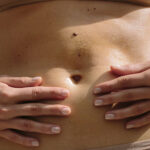
Unveiling “The Golden Effect” – Harnessing Saffron for Menstrual Health
Saffron, famously dubbed as “red gold,” stands as one of the most coveted spices globally, owing to its exquisite nature

Even though the female cycle is a recurring monthly physical ritual for most menstruating women, very few people realise how important it is to support the cycle phases with the right food choices. In this article, we explain which phases there are, what effects nutrition has during these phases and what you should always pay attention to.
Menstruation is one of the most complex hormonally controlled processes in our female body, a process during which the body and mind recreate themselves. Mood swings, water retention, cramps, tiredness and migraines are provoked by the fluctuations in the hormone balance and our mood sinks. A phase in which our health takes center stage and we should also indulge our needs and desires. Now is the time to support our bodies with the right food choices and counteract menstrual cramps, dysmenorrhoea and premenstrual syndrome (PMS). A healthy, balanced and above all vitamin-rich diet helps us to alleviate symptoms and increase our well-being during the individual phases of the period.
A woman’s cycle phases not only differ in terms of hormonal and anatomical processes, but each of the four phases also requires an adapted diet. In general, a diet rich in vitamins and avoiding empty calories, such as those found mainly in fast food dishes, is also important here. A diet adapted to the hormonal balance is not only good for well-being and health, but also helps the female body to achieve and maintain balance in each individual phase. We can roughly divide menstruation into two periods – without going into detail about the four individual cycle phases in this article – the period of blossoming, “spring and summer,” and the period of letting go, “autumn and winter”.
Blossoming phase
The phase of blossoming and reinvention; from the last day of menstruation including the next ovulation (follicle and ovulation phase):
Letting go phase
The phase after ovulation until the end of menstruation (luteal phase and menstrual phase):
This phase is also interesting for fans of dark chocolate. Not only does it satisfy our craving for sweets, but its high potassium content also supports muscle function when cramps occur during menstruation. Cocoa beans also contain valuable antioxidants that have a cell-protecting effect.
Overall, recipes with a high proportion of valuable protein sources, fresh vegetables, herbs and antioxidants are preferable in these phases. You can supplement your diet with the necessary minerals and vitamins by taking well-adjusted food supplements during the individual phases. In general, it is particularly important to avoid overloading your body with ready-made products and fast food, alcohol, unnecessary amounts of sugar, too much salt and caffeine.
Experience personalised care with our products, meticulously crafted to cater to the unique needs of women throughout every phase of their cycle. Elevate your well-being by effortlessly supplying yourself with essential vitamins, nutrients, and omega-3 fatty acids tailored to each stage. Explore our diverse range of products and empower yourself to take control of your cycle health.

Saffron, famously dubbed as “red gold,” stands as one of the most coveted spices globally, owing to its exquisite nature

Our body, mood, and overall well-being are greatly influenced by hormones. We become acutely aware of this influence during puberty,

Today, let’s embark on a journey through the intricate workings of our bodies and the profound influence of cycle hormones.

Experiencing sensations of fullness, abdominal pressure, bloating, and discomfort are all characteristics of an unpleasant bloated stomach, often accompanied by

While it is true that men can also suffer from cystitis, the urethra is much shorter in women than in

Migraines are a common and very unpleasant headache disorder. In Germany, around 14.8% of women and 6% of men are
![]()
123 Main Street
City Name, Region
Postal Code, Country
Designed & Developed by e-outbox.